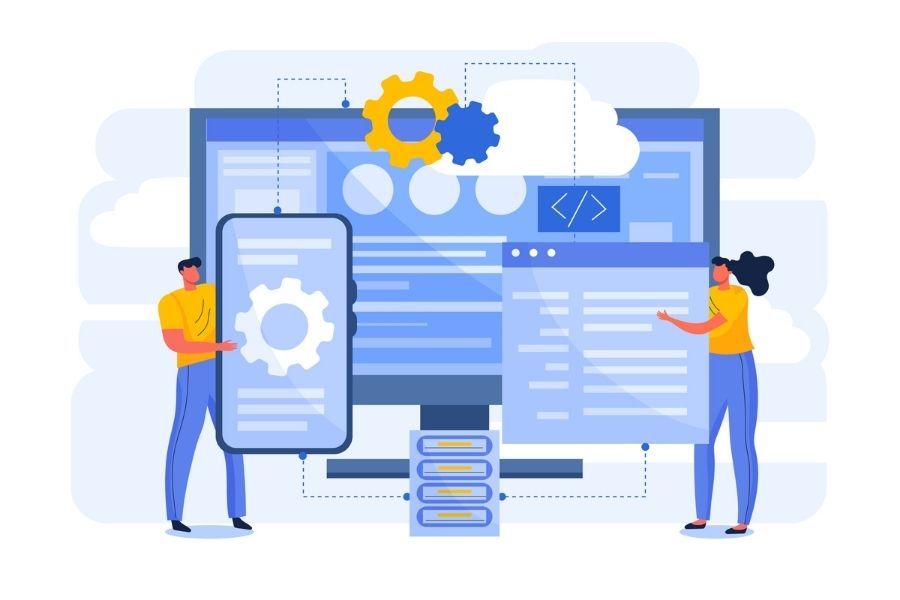Today’s businesses with the desire to scale their business often tend to be multi-channel organizations. This leads to the need for them to manage data on a single system, and so organizations often tend to move data to the cloud infrastructure. This process is called cloud migration. The transformation will help businesses narrow the gap with customers and help them better research the market, thereby speeding up the development of products and services that are more suitable to the needs of the market. In addition, some enterprises already use multiple platforms to store and sync data but regardless of their current platform, over time it will start to slow down and be limited in functionality. From there, choosing a method to move the data is necessary. One of the most popular approaches that users always wonder about is what is eCommerce replatforming. Most of the time retailers do this to improve performance through enhanced usability. In this article, we would like to explain what is eCommerce replatforming and why retailers should consider it.
What is eCommerce replatforming?
What is eCommerce replatforming is a question asked by many organizations. This is one of the ways of cloud migration. The work is no longer simply “upgrade and change” but something more complex yet more suitable for the new cloud environment. Replatforming is a process of optimizing the application during the migration phase. This requires users to have more programming knowledge and experience. They can migrate their database (DB) system to another managed DB hosted by a cloud services provider. In this type of migration, the business model may have to be revised, but the backup capabilities will be upgraded.
eCommerce replatforming refers to the process of choosing and migrating to a new eCommerce platform. It’s data migration from one online store to another including new ecosystem installation, data migration, and new website setup.
Why should retailers consider it?
Cloud computing makes a world of difference and brings tremendous growth to business operations and enterprise application infrastructure. The focus of which is that cloud servers are becoming more and more important within each enterprise. Cloud virtual servers not only bring convenience to businesses but also meet the needs of saving costs and personnel. Moving resources to the Cloud is like a completely transformative milestone for the business. This will give you a whole new work environment, new ways of doing work, utility tools and services that make your work automated, and infrastructure self-recovery.
Retailers should consider the replatforming approach for their business after understanding what is eCommerce replatforming. This transformation method will help businesses save costs and operate faster and with less risk than restructuring. It also enhances automation and improves application performance, security, and scalability over re-archiinge. This process will take a long time depending on the business objective, target platform, source technology, training requirements, industry requirements, and compliance standards of the business. The cost of replacing the platform is also going to depend on the scope of the project, the size of the team, and the technicality of the features to be changed. Replatforming can support applications with more features such as horizontal scalability or automation services and APIs (Application Programming Interface).
This method only involves changing and updating specific components of an application but not the whole, so it requires less time and money. That said, businesses will have to choose carefully which elements to update. Besides, these changes will lead to better scalability, user experience, security, and profitability. This approach also allows users to process one area of the application at a time while keeping the rest intact and running in the cloud.
Considerations before choosing or switching to replatforming
Replatforming is the right path when users can define a clear ROI (Return on Investment) for adding new features in the cloud but want to avoid the cost and downtime of full refactoring. However, retailers also need to keep a few things in mind when making a cloud migration using this method. Your organization should perform an audit before migration to identify the challenges you are trying to solve. This implementation can be divided into four categories namely technical audit, SEO (Search Engine Optimization) audit, logistics audit, and customer experience audit.
In it, SEO audit is a comprehensive process that includes thorough data collection, benchmarking activities and URL structure, and a redirect plan. It is very important to minimize damage to rankings when a new store is launched. By diving into website SEO, retailers can identify what they’re doing well, as well as what areas will need improvement in the process of understanding “what is eCommerce replatforming?” and doing this.
One factor to keep in mind in the process is the selection of the right solution. Once the audit is complete and the core requirements have been identified, you can start researching which supplier meets your needs. Besides the features it provides, users need to consider more about the viability and ease of integration. Such software solutions must ensure complete and secure updates of product, customer, and order information. It must also be able to seamlessly integrate with third-party providers in management and transactions. Most retailers rely on the best and latest technologies to fully optimize specific areas on-site but if a platform has individual extensions, there is potential for a performance boost. Taking it to the next level and allowing retailers to start operating as soon as it’s launched is a preferred tool.
Notably, before migrating data in this way, users need to crawl their eCommerce site, making sure all existing content can be cataloged. It is recommended that you check and double-check all the content and organize the ones by removing those sections and moving only the current and relevant content. Doing so will help avoid problems during the process because it can ensure that nothing needs the device to slip while moving.
Conclusion
“What is eCommerce replatforming?” is a problem many eCommerce retailers are looking to answer to meet their growing needs. This is an important process and requires a lot of time, effort, and cost. It can be tough to make a decision, so retailers should plan their move carefully. If you are looking for a solution that supports the transfer of data between sales channels, feel free to contact us.



